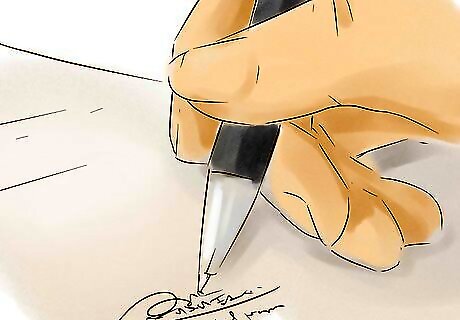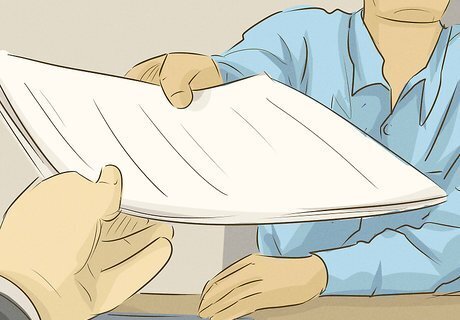
views
Responding to the Default

Receive notice of the default. You might first learn that you are in default when the court sends you a copy of the Entry of Default. You should read it and then commit to acting quickly. Generally, you don’t have much time to file a motion to set the default aside. In Alabama, for example, you only have 30 days. After getting a default, the person who sued you (the “plaintiff”) can then ask the court for a “default judgment.” This is a valid judgment, as if you had lost the lawsuit after a trial. In some situations, the plaintiff might file for default judgment at the same time as requesting default. If so, then you should see Seek Relief from Default After Judgment, since your response will be different.

Get a copy of your local court rules. Check the Entry of Default to see what court the lawsuit was filed in. Also go through your papers and see if you actually received a copy of the complaint and the summons. Once you identify the court where you were sued, you should get a copy of the court rules. These rules should be on the court’s website. Download a copy of the rules and read them. They will contain helpful information about the length, content, and formatting of your motion.

Format your notice of motion. To get the Entry of Default set aside, you need to file a written “motion” with the court. You need to give the plaintiff notice of the motion you are filing and the date you have scheduled the hearing. You can give this information by creating a Notice of Motion. Open a blank word processing document and set your font to Arial or Times New Roman 14-point type. Also set one-inch margins. Depending on your court, you might need to print the motion on “pleading paper,” which is paper numbered down the left-hand margin. Read your local rules.

Insert the caption. The caption information contains the name of the court, the names of the parties, and the case number. You can get this information from any document filed in the case. Title your notice “Notice of Motion and Motion to Set Aside Entry of Default.”

Draft the body of your notice of motion. On the first page, you can tell the plaintiff where and when the motion will be heard. You should also identify the rule of civil procedure that gives you the right to seek relief from a default. In federal court, it is rule 55(c). If you are in state court, then read your rules of civil procedure to find the right rule. In many states, the state rule is also rule 55, so start there. Sample language could read: “Please take notice that [insert a blank line for date and time], or as soon thereafter as this matter may be heard in the above-titled Court, located at [insert the location of the court], the Defendant in this case will move this Court to set aside entry of default for good cause, pursuant to Rule 55(c) of the Federal Rules of Civil Procedure. This motion is based upon the attached Motion, Declaration in Support, Exhibits, the complete files and records in this action, and upon such oral and documentary evidence as may be allowed at the hearing of this motion.” Then sign and date your Notice of Motion.

Create your motion to set aside default. In your motion, you need to explain to the judge why you failed to respond to the complaint in a timely fashion. Generally, a court can grant relief if you have a “good faith” reason for having failed to respond in time. Set up your motion in the same way you set up your Notice of Motion: same formatting, caption, etc. Title your motion “Defendant’s Motion to Set Aside Entry of Default.” State why you failed to respond in time. A court will consider any personal matters that prevented you from responding, as well as your mental state and unfamiliarity with the legal process. For example, if someone in your family died and you failed to respond, then the court might grant you relief. Explain that you have a meritorious defense. A judge is not likely to grant you relief from the default if you don’t really have a valid defense to the lawsuit. Accordingly, you need to explain why you would win the lawsuit if the judge grants you relief. For example, you could claim that the allegations in the complaint are false. Also state that the plaintiff will not be prejudiced if you are granted relief. This means that the plaintiff can still prosecute the lawsuit even if you were tardy filing a response.

Sign your motion. You always need to sign every document submitted to court. Insert a signature block and include the date. Just above the signature line include the words “Respectfully Submitted.”

Create a proposed order. In some courts, the judge will want you to submit a proposed order for him or her to sign. You should draft the order on a separate piece of paper. Include the caption information at the top. Title the order “Order Granting Defendant’s Motion to Set Aside Entry of Default.” The body of the order could read: “Having considered Defendant’s Motion and finding good cause therefore, IT IS HEREBY ORDERED that Defendant’s Motion to Set Aside Entry of Default is GRANTED. Defendant is ORDERED to file an answer or a motion pursuant to Rule 12 of the Federal Rules of Civil Procedure by [insert a blank line for the date].” Then add a line for the judge’s signature and the date.
Creating Affidavits in Support

Draft your affidavit. You need to support your motion with evidence. You can provide the evidence in the form of a signed affidavit. In the affidavit, you should explain the circumstances that prevented you from responding to the lawsuit on time. Set up the affidavit as you do the motion: caption, formatting, etc. Title it “Defendant’s Declaration in Support of Motion to Set Aside Entry of Default.” State “I have personal knowledge of the following facts, and, if called as a witness, I could and would competently testify thereto.” Tell the court how you found out about the lawsuit. Include any detail about how you tried to respond to the lawsuit. For example, you might have called the plaintiff. Go into detail about why you failed to properly respond to the lawsuit in a timely fashion. Include facts that support your defense of the lawsuit. For example, if you are being sued for personal injury, then you could state that you were not the person at fault for the car accident.

Sign the affidavit in front of a notary. Your affidavit must be signed in front of a notary. Include a signature line and then an appropriate notary block for your state, which you can find online. Include the sentence “I declare under penalty of perjury that the foregoing is true and correct” just above your signature line. You can find a notary at court, the town office, or many large banks. You will need to show acceptable personal identification, such as a valid driver’s license or passport.

Get supporting documents. You can strengthen your case by getting any evidence that supports your reason for not being able to respond to the lawsuit in time. You can then attach those documents as exhibits to your affidavit. For example, look for the following: A death certificate if a loved one died. Medical records if you were sick or injured and couldn’t respond in time. Proof that you have been away for work, e.g., a letter from your boss.

Get affidavits from helpful witnesses. Someone might have information that could help you show the judge why you couldn’t respond to the lawsuit in a timely manner. For example, if you were sick, then the doctor treating you could draft an affidavit explaining the situation. Also check whether the person could testify, if necessary, on the date and time of your motion hearing.
Filing Your Motion

Make copies of your motion. Assemble your notice of motion, motion, proposed order, affidavit, and supporting documents. Make several copies of the packet. You need one copy for your records and one copy to serve on the plaintiff. The court also might require that you file copies with the original. Check with the clerk.

Schedule your hearing date. Each court will schedule hearing dates a little differently. In some courts, you can go on the judge’s calendar and select a date and time. In other courts, the court clerk will schedule a hearing date for you. Remember not to schedule the hearing too soon. Based on your Rules of Civil Procedure, your hearing must be held a certain number of days after you file the motion. Once you have a hearing date, remember to fill in the Notice of Motion with the hearing date, time, and location.

Serve a copy on the plaintiff. You have to give the plaintiff a copy of the motion. If the plaintiff has a lawyer, then serve the copy on the lawyer. Generally, you cannot serve the copy yourself. Instead, you will need someone 18 or older to make service, usually by mail. You can have the person who makes service complete a Proof of Service form, which you can get from the court clerk. The server completes it and then returns it to you. You can attach the form to the original motion you file with the court.

File the motion with the court. Take your original and copies to the court clerk. Ask to file. You may have to pay a filing fee, which will vary by court. If you can’t afford the fee, then ask for a fee waiver form and complete it.
Attending a Hearing

Review all court documents to prepare. The plaintiff might file a response to your motion. If so, you should be sent a copy. You can prepare for your hearing by rereading your motion and reading the plaintiff’s motion. You want to understand the arguments inside and out.

Sit in on a hearing. If you have never argued a motion before, then you might want to sit in on a hearing that the judge holds before your own is scheduled. Look at the judge’s calendar and find a day when he or she holds motion hearings. Sit in the back of the courtroom with a pencil and notepad. Pay attention to how much time the judge gives each side to speak. If the judge doesn’t give parties much time, then prepare accordingly. Also listen to the questions the judge asks. Think about how you would answer the questions. You should also note how familiar the judge is with the motion being argued. Some judges don’t even read the motion before the hearing, so you might need to summarize the motion before making your argument.

Dress professionally. This is the first time the judge will have seen you, so you want to make a good impression. You should look as well-dressed as possible. If you show up looking sloppy, then the judge might assume you are careless and don’t deserve a chance to defend your lawsuit. Remember to dress conservatively and professionally. Women can wear skirts or slacks with a blouse. Women may also wear conservative dresses. Women should remember that clothing should fit comfortably but not be too tight or revealing. Men can wear dress pants and a button-up dress shirt with a tie. If a man has a suit, then he could wear that. Neither men nor women should wear blue jeans, shorts, T-shirts, tank tops, belly shirts, flip flops or hats.

Speak slowly and clearly. As the person bringing the motion, you will probably go first. You should explain to the judge why you failed to respond to the complaint in a timely manner and why you have a valid defense to the lawsuit. The judge might ask questions. Always listen quietly and don’t interrupt. Try to answer directly, with a “yes” or “no” if possible. You should always answer truthfully. Don’t guess. Instead, tell the judge you don’t know the answer to something. Always call the judge “Your Honor.”

Listen quietly to the plaintiff. The plaintiff will have a chance to make an argument as well. You must listen quietly. Don’t interrupt and don’t hold up your hand to ask the judge permission to speak. Instead, take down notes about what the plaintiff says. If the plaintiff makes a factual misstatement, then wait for the plaintiff to finish speaking. Then ask the judge if you can respond.

Wait for the judge’s decision. After hearing argument, the judge will probably issue a ruling. In some situations, the judge might take the case “under advisement” and issue a ruling later. The judge should sign your proposed order if he or she agrees with you.

Respond to the lawsuit. If the judge agrees to relieve you of the default, then you must promptly file your response to the lawsuit. Check the signed order for the deadline. If you are late again, you’ll suffer another entry of default. See Answer a Civil Court Summons for more information.




















Comments
0 comment